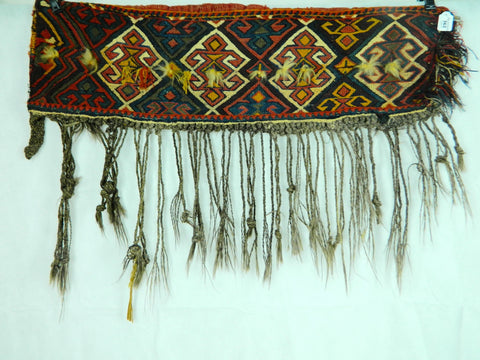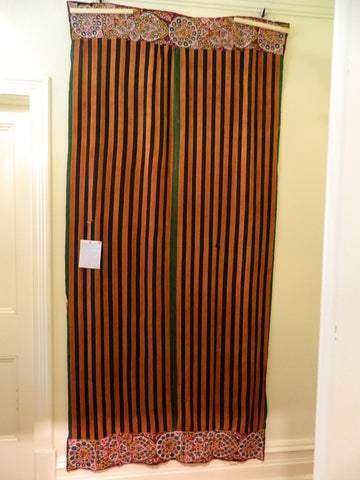




Museum piece: circa early to mid 20th century PARHA (skirt length) of hand-dyed, hand-loomed softly faded orange/red cotton, embroidered in silk and cotton by a LOHANA tribal woman probably from Diplo, Tharparker, Pakistan or Banni District just over the border in Gujarat, India. See identical piece in Victoria and Albert Museum collection IS 6-1981. (Ref: 'Colours of the Indus, Costume and Textiles in Pakistan' 1997, Askari N & Crill R, Merrell Holberton Publishers, London in assoc with Victoria & Albert Museum, London p 17). See also: http://collections.vam.ac.uk/item/O126934/skirt-cloth-unknown/
The provenance of this piece is interesting. It was bought by an American woman in London in the 1970s who was visiting her daughter who wrote to me "This is one of a series of yardage pieces that my mom bought when she visited me in London in the late 1970s. The stalls in the underground that used to be everywhere and are now closed up due to security concerns, were full of these pieces of handmade works from the ladies of India. London was the place to buy any and all of these beautiful pieces and my mother took full advantage of her treasure finds!" The woman was an artist and textile collector and took the piece back to America where he daughter remembers it displayed in her art studio. After her death, her daughter sold the wonderful and much loved textile and it travelled to me in Adelaide, Australia. I am selling it now to someone else who will love it too. 77cm x 230cm
It is an unusally embroidered and strongly designed piece made up of 3 narrow lengths of hand-loomed, hand-dyed cotton fabric 77cm long hand-sewn together. Silk and cotton thread is used to embroider a frieze in closed square chain stitch of flowers with the same stitch used in white to create strong design elements. Cross stitch fills large shapes and butterfly figures. Graphic geometric designs are filled with satin stitch. Shisha (mirror) work adds bright highlights. Peacocks and sacred lotus figures are outlined in back stitch and filled with kashmiri (herringbone) stitch. Thread colours are bright and multi-coloured in white, red, yellow, purple, pink, orange and green. The middle length of fabric is embroidered with scattered sun/flower and peacock motifs. My personal research indicates the white-dashed strip at the bottom edge is a traditional AHIR signature which is in conflict with the V&A production note "Made by the Memon or Lohana community in Tharparkar, Sindh (Pakistan) or Banni, Kutch, Gujarat (India)".
The V&A description of this textiles states: "This substantial skirt cloth would have had an additional band of fabric sewn to the top and a waistband added. A drawstring would be inserted into the waistband to pull it tight to form a full, gathered skirt with an elaborately emboidered hem.
This type of dense embroidery from Sindh in Pakistan is called 'pakko' or 'permanent' embroidery as it is so hard-wearing. Its main component is a type of buttonhole stitch which creates a distinctive ridge around the elements worked in it (in this case, the leaves and petals of the flower forms). The more geometric elements of the design are worked in small and densely packed cross-stitch, and circles of mirror-glass are added at intervals.
Embroidery of this type is mostly associated with the Thar desert areas of Sindh, but also occurr across the border in Kutch in Gujarat." (Ref: http://collections.vam.ac.uk/item/O126934/skirt-cloth-unknown/)


